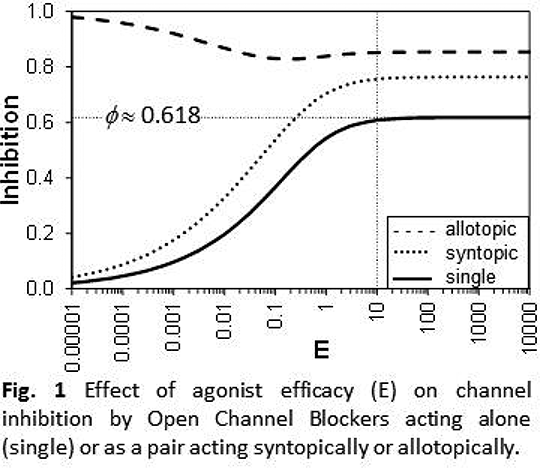Theoretical validation of the use of the Golden Approach for Open Channel Blocking Drugs We recently reported a simple method for investigating the mechanism of the action of ion channel blocking drugs (1). It addresses the question: “Do two channel-blocking drugs bind at the same site?” and works by determining the extent of channel blockade in the presence of two channel-blocking drugs using concentrations that each elicit inhibition equal to the Golden Ratio (~61.8%) when acting alone. There are two key mechanistic conditions that underlie the logic of the Golden Approach: (i) the channel-blocking drugs are not state selective; (ii) each drug does not exert an allosteric effect that modifies the binding affinity of the other. It is widely accepted that many channel-blocking drugs do not conform to this restrictive profile. To validate the Golden Approach for open channel blockers, we have conducted theoretical modelling using the following model of agonist-induced channel opening: A + R ⇔ AR ⇔ AR* A = agonist; R = channel in closed conformation R* = channel in open conformation Kd = dissociation constant (Kd = [A][R]/[AR]) E = agonist efficacy (E = [AR*]/[AR]) 
We modelled simultaneous binding of two channel-blocking drugs that act either at the same site (syntopically) or at separate sites (allotopically) under the following conditions: 1. Non-selective Channel Blockade (NCB): the affinity of the blockers is the same for R, AR and AR* 2. Absolutely-selective Open Channel Blockade (OCB): the blockers only bind to AR* Using the model, we identified conditions that maximised the predicted difference between pairs of channel blockers acting either syntopically or allotopically. Supra-maximal agonist concentrations ([A] = 1,000 × Kd) are used to ensure full occupancy. For NCB, maximisation occurs, irrespective of the value of E, when the concentrations of channel blockers used cause inhibition equal to ~61.8% when used alone. For OCB, the conditions for maximisation are dependent on E. However, Fig. 1 shows that when using high efficacy agonists (E>10, 91% channels open) the Golden Approach remains applicable for OCB. When two channel-blocking drugs bind allotopically, variance between experimentally observed and theoretically predicted results may arise as a consequence of allosteric effects. The difference between the predicted and observed inhibitions is therefore a measure of this allosterism. Further modelling will enable this effect to be quantified for both open and non-selective channel blockers. (1) Jarvis GE & Thompson AJ (2013) Trends in Pharm Sci 34: 481-488. |


